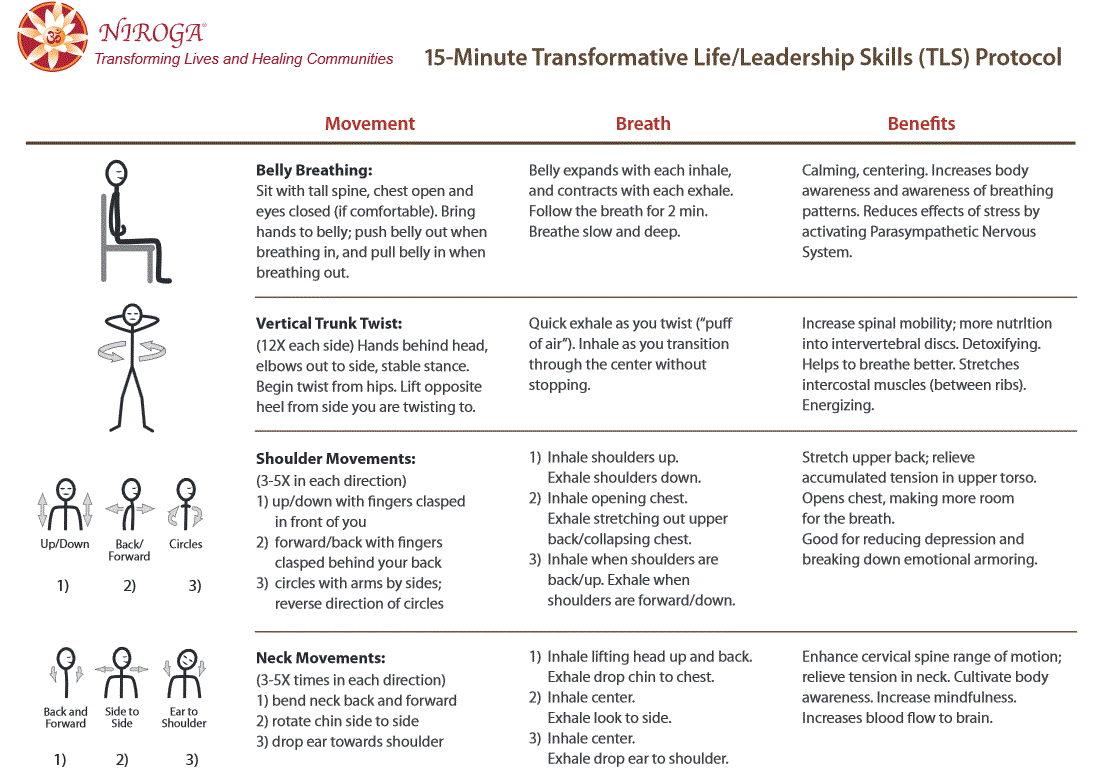On June 9-10, I completed the Niroga Institute's Dynamic Mindfulness Teacher Training exposing me to new tools that are easily adaptable for stress management, self-care and healing from trauma.
Here is a quick introduction to the ABCs:
- Activity: Start simple with your hands on your lap. Open your fingers wide, and then close them toward the shape of a fist.
- Breathing: Inhale as you open your hand. Exhale as you close your hand.
- Centering: As you continue the movement and breath, notice your whole body. Start with the distance between your moving hands and your head. Then notice your spine behind your moving hands and your head balancing on top of your spine. Then notice the support your moving hands and spine and head receive from the chair and the ground. Notice that you can have your whole body in mind as your hands move in coordination with your breath.
Drawing by Bidyut Bose at the Dynamic Mindfulness Teacher Training
What are you noticing? More relaxed or energized? More present? The wonderful part of the above is that you can do it almost anywhere ... even in a meeting under the conference room table!
Chronic stress interferes with our ability to pay attention, to be creative, to cope with what comes our way, and to empathize with others. Practicing the ABCs allows for integration across mind and body combating the stress response and improving information processing and emotional regulation.
Now, if you engage with the ABCs above again, try these variations:
- Lengthen the exhale by slowing down the closing of your hands --> you may find that you feel even more relaxed.
- Or, if you'd like to energize, length the inhale by slowing down the opening of your hands.
You can apply the ABCs to movements of your choice. Start simple movements so you can really sink into the power of the breath coordination and centering. Want to try more guided ABCs? Click the image below for a 15-minute protocol from the Niroga Institute.
- Adding to your ABCs awareness of your your whole body (like instructed above) can connect you with the natural postural mechanism - which is a cornerstone of the Alexander Technique.
I love sharing these ABCs with my Alexander Technique students. Here find the initial impact:
- In my Alexander Technique Mindful Movement Class, the ABCs left students feeling calm, energized, focused and happy!
- In a private lesson, a student with chronic back pain found these ABCs helped him break through the pain cycle which had narrowed his focus to encompass little else other than the pain. He found it provided pain relief, lifted his mood and enhanced his concentration.
- Another student with knee pain had an "aha" moment after engaging in these ABCs for a few days. She realized she was holding her breath when she felt pain in her knee that in turn contributed to the pain. She could then make another choice to allow her breath to flow to support her healing.
The Niroga Institute is reaching thousands of students a week with Dynamic Mindfulness ABCs in public schools, juvenile court placements, drug and alcohol rehab programs and other settings. They are committed to enabling healthy, compassionate and peaceful communities.
Courtesy of the Niroga Institute
To learn more about Dynamic Mindfulness and other resources for teaching youth the power of the mind-body connection, please visit my blog on teaching kids.




